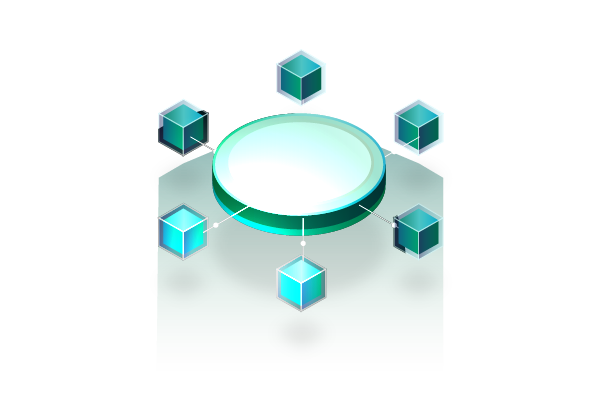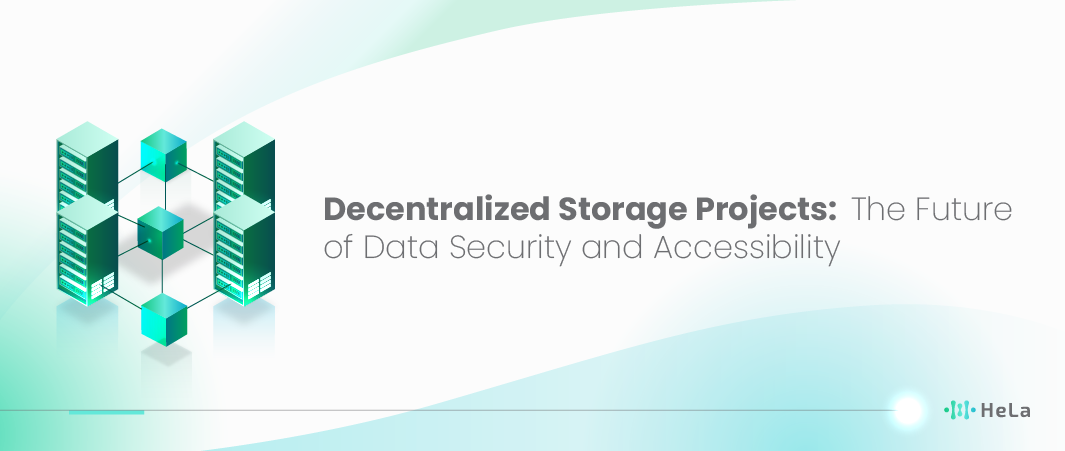As the demand for secure, scalable, and efficient data storage continues to surge, decentralized storage projects are emerging as game-changers in the technology landscape. Unlike traditional cloud storage systems, decentralized storage utilizes blockchain and peer-to-peer networks to distribute data across multiple nodes, ensuring greater security, privacy, and resilience against single points of failure. As we look toward 2025, the growing adoption of Web3, NFTs, and blockchain technology makes decentralized storage solutions more critical than ever, supporting the infrastructure needed for a fully decentralized internet.
From powering dApps (decentralized applications) to providing reliable backup solutions for enterprises and individuals, these projects are leading the charge in the data revolution. The top 10 decentralized storage projects for 2025 showcase innovations in areas like encryption, retrieval efficiency, scalability, and integration with other blockchain ecosystems, making them indispensable for anyone invested in the future of secure and decentralized data management. Whether you’re a developer, investor, or technology enthusiast, understanding these trailblazing platforms will provide valuable insights into how decentralized storage is reshaping the digital world.
What is Decentralized Storage?

Decentralized storage is one of the most groundbreaking paradigms that focus on the storage of data in many independent nodes or computers other than in only one server or data center. This method increases the overall data security, privacy, and data integrity since it limits the chances of data loss, data theft, or systems failure, which is common with centralized storage systems.
Decentralized storage works through storing data in smaller chunks, which are then encrypted before they are sent out in a network with nodes where each node has a copy of the whole data. Many of these systems are built using blockchain and peer-to-peer applications for data and information management and validation, to avoid the single point of failure.
The first advantage of decentralized storage is clearly security. Because data is dispersed and not kept in one place, it should be challenging for someone with ill intentions to obtain or compromise all of the information. Every piece of data is encrypted to further enhance their security and only those users with correct cryptographic keys can reconstruct the entire data from these fragments. This approach also has the added advantage of data correctness since any alteration of the data chunks is easily identified and fixed by the system.
Also Read: 15 Best Crypto Staking Platforms in 2025
Another very important benefit of decentralized storage is privacy. It decentralizes the control over ownership of data such that it does not lie in the hands of a single party who might not be trusted. This minimizes cases of vandalism and misuse of personnel or organizational information. Moreover, decentralized storage systems frequently utilize rewards and penalties, such as tokens, for encouraging users to share storage devices and maintain them. This forms a complex and redundant structure, where data is frequently copied and checked on various nodes.
Some of the well-known decentralized storage mediums are the InterPlanetary File System (IPFS) & Filecoin. It’s called IPFS which stands for interPlanetary File System and is a peer-to-peer protocol that aims to redesign the entire web to become faster, safer, and more open by distributing content across a network of nodes. IPFS is extended by establishing a tier on top of the economic layer in Filecoin, wherein users are compensated for their storage and retrieval of information using tokens. These systems are examples of how Decentralized storage can change the way data is processed and shared from being a centralized model which is bulky and vulnerable to unauthorized access and even manipulation to a decentralized form which allows for easier sharing of data and security and simplicity to the user.
Key Players in the Decentralized Storage Space

Decentralized storage, also known as distributed storage, is advantageous since data is stored in more than one node or servers instead of a single central node. This approach improves the security aspect because one is less likely to be attacked and in the process of encrypting the data it remains almost unreadable without the decryption keys. It also enhances privacy, whereby users get to decide how much of their data needs to be shared in an effort to have more anonymous results.
The use of multiple nodes effectively decentralizes storage, meaning that any issues with particular computing components, or even regional blackouts, do not affect data access. This also results in the conservation of cost as many of the solutions come in low storage cost and flexible deployment models such as scalable pay as you use.
The flexibility parameter is another important aspect, whereby immense changes in storage capacity are easily addressed without huge fixed-capital investments. Performance is improved because the servers are faster and the data transfer paths are shorter, which especially helps with international applications. The decentralized control eliminates the concentration of authorities in a few centers, thereby setting up a more democratic system that is difficult to censor. It can integrate with other platforms and support API access due to compatibility, providing an easy fit into other processes and environments.
With decentralized storage, many of the solutions are open-source, which allows for growth via community contributions; additionally, incentive models encourage participants. In the environmental context, decentralized storage optimizes the usage of existing resources and investigates how to lower its ecological impact by employing environmentally friendly technologies.
Works in progress to date include IPFS, Storj, Filecoin, and Sia that illustrate the applicability of the decentralized storage as well as the benefits that can accrue from new ways of sharing data with better security and privacy, high availability, and affordable cost. With the advancement of the technology, Decentralized storage is capable of occupying a significant position among the storage media of the future.
Benefits of Decentralized Storage

Decentralized storage, also known as distributed storage, offers a myriad of benefits by distributing data across multiple nodes rather than relying on a single central server. This approach enhances security by reducing vulnerability to attacks and using strong encryption, ensuring data remains unreadable without decryption keys. It also improves privacy, giving users more control over their data and higher levels of anonymity. With data replicated across multiple nodes, decentralized storage ensures greater reliability and availability, as system failures or regional outages do not compromise data accessibility. This redundancy also leads to cost efficiency, with many solutions offering lower storage costs and flexible pay-as-you-go pricing models.
Scalability is another significant advantage, allowing dynamic adjustments in storage capacity without major infrastructure investments. Performance is optimized through reduced latency and better data transfer routes, especially beneficial for global applications. Decentralized control prevents power concentration in a few entities, making the system more democratic and resistant to censorship. Interoperability is facilitated by compatibility with multiple platforms and API access, allowing seamless integration with existing workflows and technologies.
The open source nature of many decentralized storage solutions fosters community participation, innovation, and transparency, while incentive models attract users to contribute to the network. Environmentally, decentralized storage uses existing resources more efficiently and explores green technologies to reduce its carbon footprint.
Real world examples such as IPFS, Storj, Filecoin, and Sia demonstrate the practical applications and advantages of decentralized storage, highlighting its potential to revolutionize data management and distribution with enhanced security, privacy, reliability, and cost-efficiency. As the technology evolves, decentralized storage is poised to play a pivotal role in the future of data management.
Top 10 Decentralized Storage Projects in 2025

Decentralized storage projects are changing the way data is stored, protected, and retrieved with the help of blockchain. These projects are designed as more secure, private, and reliable replacements for regular cloud storage solutions. Here are top ten decentralized storage projects:
1. Filecoin (FIL)
Filecoin (FIL) is an open-source blockchain based storage marketplace that intends to revolutionize cloud storage. Filecoin was founded by Protocol Labs in October 2020 as an attempt to improve the current centralized cloud storage mechanisms by integrating blockchain solutions. The network enables users to lease space on their hard drives, which is more efficient as data is distributed among many participants.
Filecoin encourages users to stake their nodes by providing them with FIL tokens in exchange for their storage space and connection bandwidth. This approach decongests the centralized data centers but at the same time helps in improving data security and data authenticity due to the scattering of files in many locations. Some examples of the applications that are built on the Filecoin ecosystem include personal data storage or business data solutions, and also the Filecoin protocol is compatible with other decentralized protocols in constructing Web3.
2. Arweave (AR)
Arweave (AR) is a decentralized storage network designed to provide a permanent and scalable solution for data archiving. Launched in 2018 by Sam Williams and William Jones, Arweave utilizes a novel technology called “blockweave,” which differs from traditional blockchain by enabling more efficient storage and retrieval of data. In a blockweave, each new block contains a hash of a previous block, making data retrieval quicker and ensuring data integrity.
Arweave’s unique “proof of access” consensus mechanism incentivizes miners to replicate and store data, ensuring its permanence. Users pay a one-time fee to store data forever, creating a sustainable economic model. Arweave has attracted attention for its potential to revolutionize data storage, offering an immutable, censorship resistant solution that contrasts sharply with traditional centralized cloud services. Its applications range from preserving historical records and academic research to providing transparent and tamper-proof storage for digital content.
3. InterPlanetary File System (IPFS)
InterPlanetary File System (IPFS) is a distributed file storage that has goals to make the web faster, more secure and open. While there is a centralized system where the data is stored on a certain server, IPFS uses P2P to store and share the files. This means that when a data request is made, it is fetched from many nodes, making it even more reliable and robust.
In another method known as content-addressing, each file is provided with a unique hash making IPFS immune to duplication. This method also results in better and safer means of sharing files since files are referenced by their contents and not by their locations. Additionally, IPFS can solve problems like censorship and Minimize bandwidth costs which make it a promising solution for the future of the net.
Also Read: Top 10 Fastest Blockchain Platforms in 2025
4. Siacoin (SC)
Siacoin (SC) is the native asset of the Sia network, the primary objective of which is to disrupt the cloud storage industry using blockchain. Developed by the Sia project, Siacoin helps people provide decentralized storage services. Thus, people willing to share their idle storage space can do it safely and effectively. It also helps to ensure data sovereignty, backups, and efficiency, making Sia a competitor to centralized cloud storage services such as Amazon S3, Google Drive, and Dropbox.
Paying hosts with Siacoin, users compensate the hosts for providing storage services. All storage contracts and transactions are documented on the blockchain which increases its transparency and security. Siacoin’s competitive advantage is in its potentiality to undercut current centralized storage solutions and provide additional layers of security from decentralization.
5. Storj Labs Inc. (STORJ)
Storj Labs Inc. is an organization that provides solutions in distributed computing through the sharing of storage space via the blockchain. Being initiated in 2014 and having the headquarters in Atlanta, Georgia, Storj has adopted to relieve clients from the disadvantages of conventional cloud storage solutions in terms of security, privacy, and cost. Tardigrade, the platform provided by the company, enables users to store their data across a network of nodes for better protection and secure data storage with limited chances of leakage.
Storj, allowing users to import their storage capacity with unused space from people and data centers around the globe for STORJ tokens, the native currency of the company. Apart from enhancing data privacy and isolation along with data protection it also provides greater flexibility and modularity and balanced resource utilization for enterprises and developers by providing a distributed architecture. Despite some similarities with competitors, Storj has some unique traits in its model and unyielding focus on data ownership and sovereignty that draw attention to the growing market of decentralized storage services.
6. BitTorrent (BTT)
The BitTorrent (BTT) is an altcoin related to the BitTorrent system of peer to peer file sharing that was created by Bram Cohen in 2001. BitTorrent hopes to enhance the delivery of files in the BitTorrent network, by using the tokens for seeding and file sharing. The incorporation of blockchain technology in BitTorrent allows for distribution and storage of data without necessarily relying on centralized systems and this improves performance of the system.
The bandwidth and other resources are provided by users and they receive BitTorrent tokens for it, while the same tokens can be used to purchase prioritized download and high speed connection. Such tokenization helps in making the ecosystem more balanced and effective that also reciprocates the participation and contributions of the users. The integration of BitTorrent also indicates a progression in the distribution of digital assets through assured networking based on P2P and blockchain technology for users benefit.
7. Flux
FLUX is an ERC-20 token used for working on the decentralized cloud computing platform known as the Flux Network. Now it performs several crucial roles in the system, being a utility token and one of the governance tokens. FLUX is employed for purchasing computing, storage, and other computational services from nodes of the FLUX network. This encourages the node operators to keep the network afloat and growing, by working towards it while being compensated for it.
Furthermore, FLUX ensures smooth interaction and trade on the platforms of the dApp environment based on the Flux Network. Aside from the use-case, FLUX also has the function of governance within the network and grants its holders the ability to work on proposals for altering the FLUX protocol. This dual use case also serves as one of the safeguards to maintain the decentralized and community-led form, creating a sustainable and scalable ecosystem for Web3 app development and deployment.
8. Ocean Protocol
At a time when numerous players had already established their clouds, The Ocean Protocol joined the fray in 2017. It is an integrated, globally located P2P data exchange marketplace that opens for all. The Singapore-based platform is a fully decentralized P2P data exchange marketplace. Users can specify a segment and share available storage options and data through this decentralized marketplace. The data are exchanged between parties using blockchain technology, and Ocean Protocol provides one such ecosystem.
Based on Ethereum, Ocean Protocol blockchain works with smart contracts to ensure DAICO cooperation in the sharing of data as per agreements between the parties involved in the network. This would make sure that data providers are given a lot of say on how their data is consumed by other parties while at the same time, making sure that data consumers are given an easy time when it comes to finding data sets that they deem relevant to their input.
This entails having a Decentralised Marketplace aided by Ocean Tokens (OCEAN) where the data assets can be posted, found or exchanged in the protocol. This blockchain architecture does not just provide superior data protection through encrypted file sharing and access authorities but also enables data sharing and reusability across the various applications and services. Ocean Protocol, therefore, wants to use blockchain to bring data availability for all people, data sharing and contributing, and create a marketplace that will promote using AI and machine learning breakthroughs on the Ocean.
9. Akash Network
Akash Network started in the sector in 2015 and is located in San Francisco, CA. Akash Network is all about cloud computing infrastructure as a decentralized marketplace and platform built on the principles of blockchain. In that regard, Akash intends to break the monopoly of cloud giants like AWS, Azure, Google Cloud, by decentralizing cloud services. This one is based on the decentralized model where people and SMEs can contribute their unused hardware resources, forming the distributed computing environment. This approach not only has the possibility of reducing costs, but also increase the scale and effectiveness since supply and demand can be connected immediately.
At the core of the offering is the AKT token, which is an integral part of Akash Network and has various functions within the platform. It is used for acquiring computing services, encourages individuals to contribute their resources in the network, and allows the holder to participate in the governance decision-making. And this tokenomics model guarantees that all the participants in the ecosystem get their reward for contributing to it, and that everyone shares the same goals and incentives.
10. Crust Network
Crust Network is a decentralized storage network for the distributed storage of information through the use of the Crust protocol. Crust, which is based on the framework called Substrate, foregrounds the use of blockchain technology for decentralized storage solutions. It is meant to address issues that revolve around the conventional cloud storage solutions while offering a peer-to-peer community that adopts privacy-inherent protocols for data sharing.
Crust Network stimulates the participants economically to contribute their storages and connections, ensuring that it has a vast and strong network. It is suitable for different applications such as smart contracts, big data storage for enterprises, and CDN. As a decentralized data storage solution emphasizing security, reliability, and decentralization, Crust Network breaks new ground in the field.
Conclusion
These are critical components in the new world of digital infrastructure since they focus on functional approaches to storage of data. The first and foremost is that these top ten projects reveal various directions and tools used for improvement of security, privacy, and accessibility.
The concept of file storage has been embraced by several pioneers such as Filecoin and Storj by deploying block chain based solutions that will guarantee data integrity and decentralization, and concepts such as Arweave that will guarantee long term storage of data. While Siacoin highlights the problem of its decentralized marketplace’s low cost. Some such as IPFS focus more on the distribution, availability and visibility of content using decentralized methods.
The unifying theme of all these projects is their goal of radically reimagining digital storage in decentralized ways and using the web without relying on central authorities. These decentralized storage projects are still growing and adapting, and as they are increasingly integrated into data storage services, they will become a major factor in the development of novel security systems.
Disclaimer: The information provided by HeLa Labs in this article is intended for general informational purposes and does not reflect the company’s opinion. It is not intended as investment advice or a recommendation. Readers are strongly advised to conduct their own thorough research and consult with a qualified financial advisor before making any financial decisions.

